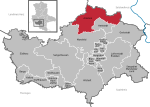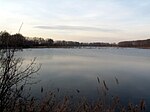Aschersleben/Land
Former Verwaltungsgemeinschaften in Saxony-AnhaltSalzlandkreis geography stubs
Aschersleben/Land is a former Verwaltungsgemeinschaft ("collective municipality") in the Salzlandkreis district, in Saxony-Anhalt, Germany. The seat of the Verwaltungsgemeinschaft was in Aschersleben. It was disbanded in January 2009.At the end of 2008, the Verwaltungsgemeinschaft Aschersleben/Land consisted of the following municipalities: Aschersleben Groß Schierstedt Schackenthal Westdorf
Excerpt from the Wikipedia article Aschersleben/Land (License: CC BY-SA 3.0, Authors).Aschersleben/Land
Albert-Drosihn-Straße,
Geographical coordinates (GPS) Address Nearby Places Show on map
Geographical coordinates (GPS)
| Latitude | Longitude |
|---|---|
| N 51.75 ° | E 11.466666666667 ° |
Address
Albert-Drosihn-Straße 7b
06449 (Aschersleben)
Saxony-Anhalt, Germany
Open on Google Maps





